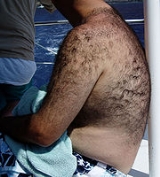
Hair removal
Overview
Hair removal is the removal of body hair, and describes the methods used to achieve that result.
Hair typically grows all over the human body during and after puberty
. Men tend to have more body hair than women. Both men and women tend to have hair on the head
, eyebrow
s, eyelash
es, armpits, pubic region and legs
; and men also have hair on their face
, abdomen
, back
and chest
. Hair does not generally grow on the palms of the hands, the lips, certain areas of the genital structure, or the soles of the feet.
Forms of hair removal are practised for a number of reasons, including cultural, sexual, medical and religious.
Hair typically grows all over the human body during and after puberty
Puberty
Puberty is the process of physical changes by which a child's body matures into an adult body capable of reproduction, as initiated by hormonal signals from the brain to the gonads; the ovaries in a girl, the testes in a boy...
. Men tend to have more body hair than women. Both men and women tend to have hair on the head
Hair
Hair is a filamentous biomaterial, that grows from follicles found in the dermis. Found exclusively in mammals, hair is one of the defining characteristics of the mammalian class....
, eyebrow
Eyebrow
The eyebrow is an area of thick, delicate hairs above the eye that follows the shape of the lower margin of the brow ridges of some mammals. Their main function is to prevent sweat, water, and other debris from falling down into the eye socket, but they are also important to human communication and...
s, eyelash
Eyelash
An eyelash or simply lash is one of the hairs that grow at the edge of the eyelid. Eyelashes protect the eye from debris and perform some of the same function as whiskers do on a cat or a mouse in the sense that they are sensitive to being touched, thus providing a warning that an object is near...
es, armpits, pubic region and legs
Leg shaving
Leg shaving is the practice of removing leg hair by shaving the hair off using a razor or electric shaver. In addition, some people remove leg hair using waxing, sugaring, depilatories, depilation devices, or lasers, but shaving remains the least expensive method.It is a very common practice among...
; and men also have hair on their face
Facial hair
Facial hair is a secondary sex characteristic of human males. Men often start developing facial hair in the later years of puberty or adolescence, approximately between 17–20 years of age, and most do not finish developing a fully adult beard until their early 20s or even later...
, abdomen
Abdominal hair
The term abdominal hair refers to the hair that grows on the abdomen of humans and non-human mammals, in the region between the pubic area and the thorax . The growth of abdominal hair follows the same pattern on nearly all mammals, vertically from the pubic area upwards and from the thorax...
, back
Human back
The human back is the large posterior area of the human body, rising from the top of the buttocks to the back of the neck and the shoulders. It is the surface opposite to the chest, its height being defined by the vertebral column and its breadth being supported by the ribcage and shoulders...
and chest
Chest hair
The term chest hair is generally used to describe hair that grows on the chest of human males, in the region between the neck and the abdomen. Chest hair, which is a secondary sex characteristic, develops during and after puberty...
. Hair does not generally grow on the palms of the hands, the lips, certain areas of the genital structure, or the soles of the feet.
Forms of hair removal are practised for a number of reasons, including cultural, sexual, medical and religious.

